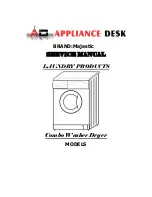
●
Check if it’s necessary to refill with dishwasher salt or rinse
aid
●
Load cutlery and dishes into the dishwasher.
●
Fill with dishwasher detergent .
●
Select a wash programme suitable for the cutlery and
dishes.
●
Start the wash programme.
Loading cutlery and dishes
Sponges, household cloths and any object that can
absorb water may not be washed in the dishwasher.
●
Before loading the dishes, you should:
- Remove all left over food and debris.
- Soften remnants of burnt food in pans
●
When loading the dishes and cutlery, please note:
- Dishes and cutlery must not impede the rotation of the
spray arms .
- Load hollow items such as cups, glasses, pans, etc. with
the opening downwards so that water cannot collect in the
container or a deep base.
- Dishes and items of cutlery must not lie inside one
another, or cover each other.
- To avoid damage to glasses, they must not touch.
- Lay small objects in the cutlery basket.
●
Plastic items and pans with teflon have a tendency to
retain water drops; these items will not dry as well as
porcelain and steel items.
Open the door and slide out the baskets to load the dishes.
The lower basket
The lower basket is designed to take saucepans, lids, plates,
salad bowls, cutlery etc.
Serving dishes and large lids should be arranged around the
edge of the basket, ensuring that the spray arms can turn
freely.
The cutlery basket
Long bladed knives stored in an upright position are a
potential hazard.
Long and/or sharp items of cutlery such as carving knives
must be positioned horizontally in the upper basket.
Take care when loading or unloading sharp items such as
knives.
Forks and spoons should be placed in the removable cutlery
basket with the handles facing downwards and the knives with
their handles facing upwards.
If the handles protrude from the bottom of the basket,
obstructing the lower spray arm, load the cutlery with the
handles facing upwards.
Mix spoons with other cutlery to prevent them from sticking
together.
For best results we
recommend you to use the
cutlery grid provided (if the
size and dimensions of the
cutlery allow it).
In daily use
9
For washing in the dishwasher the following cutlery/dishes
are of limited suitability:
- Only wash stoneware in the dishwasher if it is specifically
marked as being dishwasher-safe by the manufacturer.
- Glazed patterns may fade if machine washed frequently
- Silver and aluminium parts have a tendency to discolour
during washing. Residues, e.g. egg white, egg yolk and
mustard often cause discolouring and staining on silver.
Therefore always clean left-overs from silver immediately, if
it is not to be washed straight after use.
- Some types of glass can become dull after a large number
of washes
are not suitable:
- Cutlery with wooden, horn, china or
mother-of-pearl handles
- Plastic items that are not heat resistant
- Older cutlery with glued parts that are not temperature
resistant
- Bonded cutlery items or dishes
- Pewter or copper items
- Lead crystal glass
- Steel items prone to rusting
- Wooden platters
- Items made from synthetic fibres
Содержание ZI 627
Страница 1: ...DISHWASHER ZI 627 INSTRUCTION BOOK ...
Страница 18: ......
Страница 19: ......
Страница 20: ...Subject to change without notice 152950 05 0 02 06 ...






































